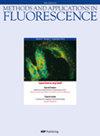用于癌症靶向光动力学治疗的近红外上转换纳米材料的最新进展
IF 2.4
3区 化学
Q3 CHEMISTRY, ANALYTICAL
引用次数: 6
摘要
光动力疗法(PDT)是一种成熟的癌症治疗方法,它使用有毒的活性氧,包括单线态氧(1O2),由光敏剂(PS)药物在特定波长照射后产生,以破坏癌细胞和肿瘤。可见光通常用作PDT的激发源,由于其组织穿透性降低,因此对深部肿瘤的治疗效率低下,因此不适合用于癌症治疗。此外,这些波长表现出来自生物组织的升高的自身荧光背景,这阻碍了光学生物医学成像。紫外-可见照射的另一种选择是使用近红外(NIR)激发进行PDT。这可以通过使用光敏剂药物功能化的上转换纳米颗粒(UCNPs)来实现,其中UCNPs可以用作近红外激发后产生单线态1O2的PS药物激活的间接激发源。纳米颗粒用于PDT也是有益的,因为它们的肿瘤靶向能力,无论是被动地通过增强的渗透性和保留(EPR)效应,还是主动地通过刺激反应靶向和配体介导的靶向(即使用识别单元,可以结合特异性受体仅存在或过度表达在肿瘤细胞上)。在这里,我们回顾了用于癌症PDT的近红外上转换纳米材料的最新进展,并明确区分了那些由于EPR效应(被动靶向)的积累而可能潜在靶向肿瘤的纳米颗粒和基于纳米颗粒的靶向剂,其目的是通过分子识别过程主动靶向肿瘤。本文章由计算机程序翻译,如有差异,请以英文原文为准。
Recent advances in near infrared upconverting nanomaterials for targeted photodynamic therapy of cancer
Photodynamic therapy (PDT) is a well-established treatment of cancer that uses the toxic reactive oxygen species, including singlet oxygen (1O2), generated by photosensitiser (PS) drugs following irradiation of a specific wavelength to destroy the cancerous cells and tumours. Visible light is commonly used as the excitation source in PDT, which is not ideal for cancer treatment due to its reduced tissue penetration, and thus inefficiency to treat deep-lying tumours. Additionally, these wavelengths exhibit elevated autofluorescence background from the biological tissues which hinders optical biomedical imaging. An alternative to UV–Vis irradiation is the use of near infrared (NIR) excitation for PDT. This can be achieved using upconverting nanoparticles (UCNPs) functionalised with photosensitiser drugs where UCNPs can be used as an indirect excitation source for the activation of PS drugs yielding to the production of singlet 1O2 following NIR excitation. The use of nanoparticles for PDT is also beneficial due to their tumour targeting capability, either passively via the enhanced permeability and retention (EPR) effect or actively via stimuli-responsive targeting and ligand-mediated targeting (i.e. using recognition units that can bind specific receptors only present or overexpressed on tumour cells). Here, we review recent advances in NIR upconverting nanomaterials for PDT of cancer with a clear distinction between those reported nanoparticles that could potentially target the tumour due to accumulation via the EPR effect (passive targeting) and nanoparticle-based systems that contain targeting agents with the aim of actively target the tumour via a molecular recognition process.
求助全文
通过发布文献求助,成功后即可免费获取论文全文。
去求助
来源期刊

Methods and Applications in Fluorescence
CHEMISTRY, ANALYTICALCHEMISTRY, PHYSICAL&n-CHEMISTRY, PHYSICAL
CiteScore
6.20
自引率
3.10%
发文量
60
期刊介绍:
Methods and Applications in Fluorescence focuses on new developments in fluorescence spectroscopy, imaging, microscopy, fluorescent probes, labels and (nano)materials. It will feature both methods and advanced (bio)applications and accepts original research articles, reviews and technical notes.
 求助内容:
求助内容: 应助结果提醒方式:
应助结果提醒方式:


